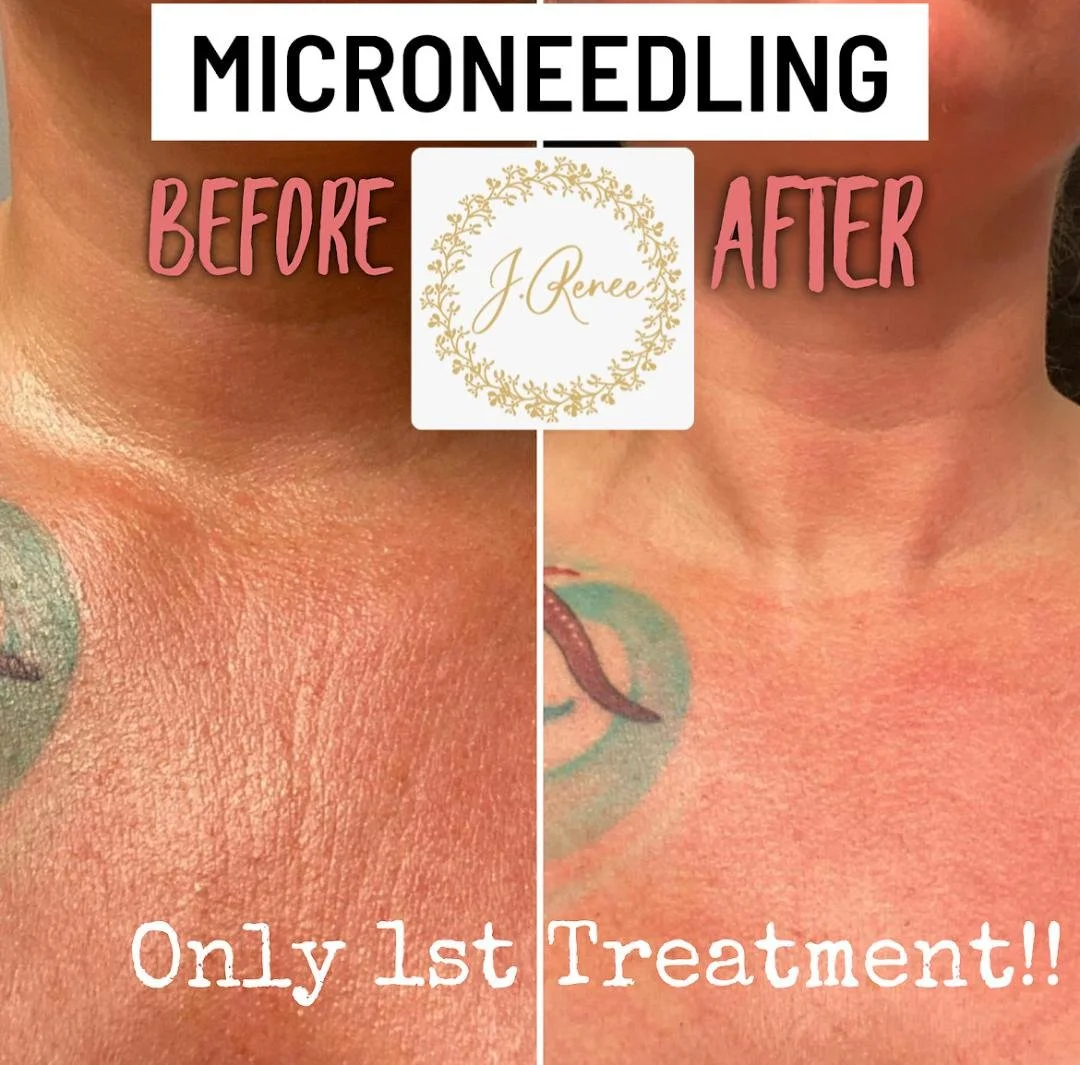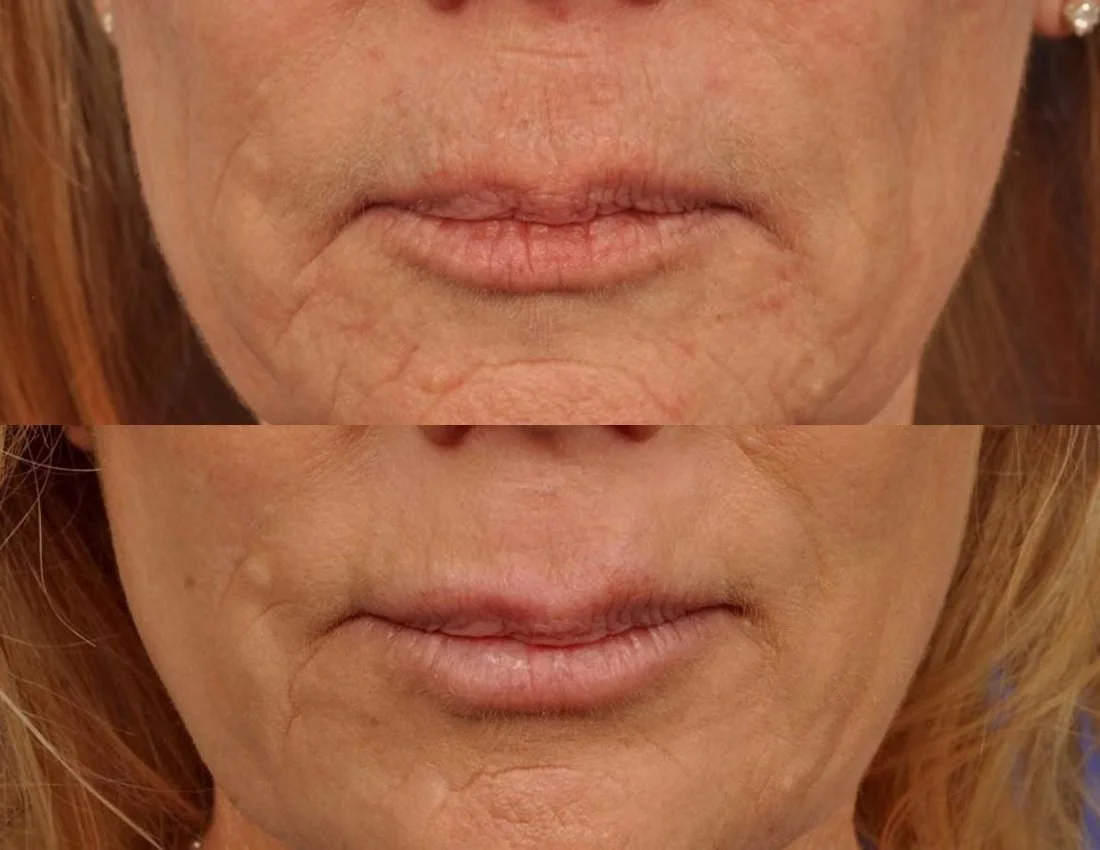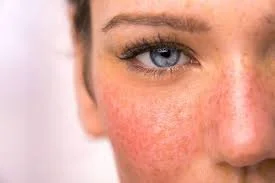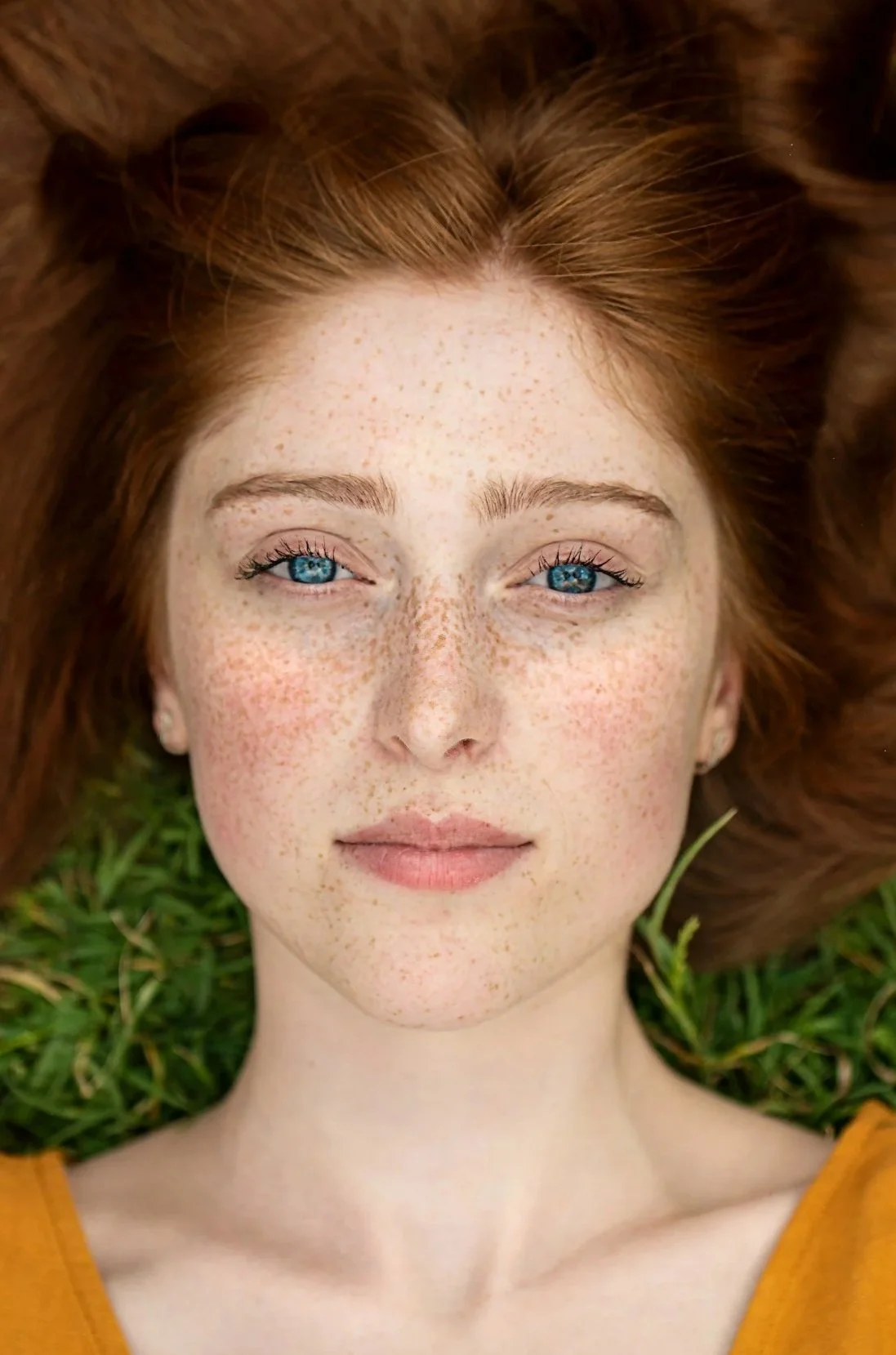J Renee Organics Skin and Beauty Blog:
Skin Advice for a Natural, Healthy, Glowing Complexion
Blog Search:
Mesmerizing Microneedle 400% Collagen Increase!
A 2008 study proved that the amount of collagen and elastin in the skin of people post microneedling increased by an impressive 400%! Microneedling is amazing for anti-aging, acne scars, hyperpigmentation and more. It’s natural, safe and effective.
Microneedling is Simply Amazing!
This is my chest and yes, it looked this good right after 1 microneedling treatment. Because I sleep on my side and I have a large bust, I get significant chest wrinkles (I’m 47). Even though I have EXTREMEMLY sensitive skin, I do microneedling on my face and chest every 2 months; it reverses sun damage and preserves the integrity of my thinning skin, making it look MUCH younger than it is. Many people guess my age to be 10+ years younger than I am.
Shelly Todd, Esthetician of 13+ years
SCHEDULE NOW
Just Face - Face & Neck - Face, Neck, Chest - Hair Restoration
About Microneedling:
In a 2008 research study, it was proven that after undergoing repeated micro-needling procedures, the amount of collagen and elastin in the skin of the patients increased by an impressive 400% after just 6 months. Furthermore, the skin became noticeably plump, smooth, and rejuvenated after 1 full year, highlighting the long-term benefits of this innovative treatment.
Microneedling causes “micro-injuries” that help stimulate the skin to repair itself naturally through a process called dermal remodeling. This remodeling kick-starts your natural healing process, which stokes collagen production.
The tiny punctures immediately stimulate fibroblast activity, which starts the one-week stage of inflammation. The next phase (proliferation), is where fibroblasts and keratinocytes produce collagen. The structure of the new collagen fibers is similar to that of undamaged, youthful skin. Simultaneously, new blood vessels are created that provide adequate vascularization and oxygenation for the newly formed tissue. During the last phase (remodeling), the skin becomes thicker and creates the support, strength and flexibility for the new skin.
To provide time for all the described stages and for the best results, it’s important to wait 3–6 weeks between micro-needling sessions. For older, more wrinkled skin, or skin that has extensive acne scarring, a series of micro-needling sessions should be performed for more dramatic results. How may treatments your skin needs to reach your goals will be assessed and you will be well informed before deciding on a treatment plan of action.
Because sensitive skin can’t handle stronger peels & sometimes microdermabrasion, Microneedle treatments are my go-to for not only my own sensitive skin, but all of my aging client’s skin, even if they are extremely sensitive!
J. Renee Esthetics microneedling sessions go beyond the ordinary by pairing advanced techniques tailored to maximize your skin’s potential. Each session combines a gentle enzyme peel to cleanse and prepare your skin, L.E.D. Light therapy to soothe and stimulate cellular activity, and—when your skin type allows—microdermabrasion for refined texture and increased absorption. This powerful trio jumpstarts your skin’s natural collagen and elastin production, delivering visible improvements in texture, tone, and firmness from the very first treatment—followed by microneedling continuing to enhance your complexion with lasting results. At J. Renee Organics, we don’t just treat skin; we transform it using an all-natural and healthy approach.
Microneedling is proven to help with:
Acne and other scars, lessen depth, even skin tone
Dark spots: age spots, sun spots, scars, etc.
Large pores, plumps skin to make pores appear smaller
Sagging skin, rebuilds skin structure
Uneven skin texture and tone
Wrinkles and fine lines
Even-out skin tone in melasma conditions
BEFORE & AFTERS
Mast Cells, Histamine & Your Skin
Rosacea, acne, melasma and other skin conditions are affected by mast cells and histamine. Learn how to calm the reaction with diet, supplementation of herbs and vitamins and with skincare products and services. Also learn about antihistamine drug types and how they may help with these skin conditions.
Skin Issues Because of Histamine
Mast cells are a type of white blood cell that protect the body by releasing chemical mediators, such as histamine, to fight off germs, parasites, and toxins. Mast cells reside in many parts of the body, including the skin. In the process of protecting the body, mast cells release histamine and induce inflammation. This process is essential for a healthy, healing body and building immunity to pathogens, but when it goes awry, it can contribute to sickness and skin conditions like Melasma, Acne, Rosacea and other skin issues.
Acne: Because histamine causes skin irritation and inflammation, it can trigger and worsen acne breakouts. Histamine also stimulates melanin production (darkening of skin). This is the reason I absolutely DO NOT recommend anyone with acne seeking out the sun for acne treatment; UV exposure exponentially raises the chances of life-long acne hyperpigmentation scarring.
Melasma: In melasma, an increased number of mast cells (and histamine) are found in the affected skin, especially after sun exposure. When someone with Melasma gets sun, the melanocytes overproduce melanin, leaving them with dark patches of skin. Both ultraviolet (UV) radiation and visible light (VL) from the sun contribute to this process, causing existing dark patches to deepen and new ones to form. Also, sun exposure damages skin cells and triggers inflammation, which further stimulates melanocytes to produce more pigment, creating a persistent cycle of discoloration.
Rosacea: Mast cells and the histamine they release play a central role in the development of rosacea, influencing inflammation, vasodilation, and nerve activity. Research shows that people with rosacea have an increased number and activity of mast cells in their facial skin. Histamine released from these activated mast cells exacerbates flushing, while other released substances drive the inflammatory cascade and contribute to the development of skin thickening seen in advanced rosacea.
Cherry Angiomas: Mast cells also release tryptase, promoting the growth of new blood vessels (vascular proliferation) which show up on the skin as cherry angiomas or red moles.
Eczema, dermatitis and Psoriasis: Studies have shown that histamine levels are elevated in the skin of patients with these conditions. Antihistamines have been investigated as a potential treatment, however because histamine is only one of many inflammatory mediators involved in these conditions, it’s not very effective in treating them.
Solutions for Better Skin
Diet: Consuming a low histamine diet helps dramatically reduce symptoms of histamine related skin conditions and other bodily symptoms of histamine overload. The list of low and high histamine food is a general list; some people have higher and lower sensitivity to triggering foods and would have to do an elimination diet to find their exact triggers.
AVOID:
All fermented food: kefir, kombucha, Sauerkraut, yogurt, kimchi, tempeh, miso, apple cyder vinegar, some cheeses, olives, sour cream anything pickled, beer
All aged/cured food: Aged cheeses, buttermilk, sour cream, aged/smoked/cured meats, sausage, bacon, pepperoni, wine & spirits, sourdough, vinegar, dried fruit, ALL PRESERVED FOOD (no fast food, TV dinners, left overs or boxed or canned food)
Sea food (very high in histamine): ALL SEA FOOD, even sea food right out of the ocean has high histamine levels, but as they age, they are extremely high.
Fruits and Vegetables: bananas, strawberries, all citrus fruit, tomato, avocado, pineapple, papaya, cherries, eggplant, spinach, squash, mushrooms
Nuts: Walnuts, peanuts, cashews, chickpeas
Bakery and Sweets: Chocolate, artificial sweeteners, yeast
Spices: Allspice, anise, cinnamon, chili powder, clove, curry powder, cayenne, msg, nutmeg, paprika
Supplements: Fish oil
ENJOY:
Dairy & Alternatives: Pasteurized milk, butter, cream, mozzarella, ricotta, cottage, mascarpone, cottage cheese, Almond milk, Coconut milk, Rice milk and Oat milk
Vegetables and Fruit: All but listed in “avoid”
Protein/Meat: All fresh meat, eggs, lentils, red beans, soybeans/tofu. COOK or FREEZE RIGHT AWAY.
Grains: Amaranth, arrowroot, buckwheat, millet, rice, quinoa
Nuts: Almonds, Brazil nuts, Chestnuts, Coconut meat, Flax seeds, chia seeds, Hazelnuts, Macadamia nuts, Pecans, Pistachios, Pumpkin seeds, Sesame seeds, and Sunflower seeds
Oils: Olive oil, coconut oil
Sweets: Monk fruit, stevia, maple syrup, honey and sugar
Food Preparation
How and when you prepare and store your food is also a factor in the histamine content of a meal. To reduce histamine in your food prep, prioritize using the freshest ingredients possible and minimize the time between cooking and eating. Histamine levels increase as food ages, and while freezing can slow this process, it does not stop it completely. You should freeze leftovers immediately, as well employing the following meal prep tips:
Choose boiling and steaming. Studies show that boiling and steaming can decrease histamine levels, while high-heat methods like frying and grilling may increase them. An Instant Pot can also be a good option for faster cooking.
Use low-histamine seasonings. Flavor your food with low-histamine herbs and spices, such as ginger, turmeric, oregano, and basil. Avoid spices like cinnamon, cloves, or curry powder, which are higher in histamine.
Add "anti-histamine" foods. Incorporate ingredients that may have natural anti-histamine effects into your cooking, such as onions, garlic, apples, and blueberries.
Use glass or silicone containers. Use high-quality, airtight glass or silicone containers for storing prepped ingredients and frozen meals to prevent oxidation and chemical leaching from plastics.
Cool food quickly. After cooking, cool food in small, shallow containers to reduce the time it spends at lukewarm temperatures, which promotes bacterial growth.
Reheat frozen meals only once. Reheat frozen meals quickly, ideally straight from the freezer, and avoid reheating the same portion multiple times.
Transport food safely. If you are taking food on the go, use an insulated bag with freezer packs to keep the temperature stable and minimize histamine increases.
Natural anti-histamine supplements, herbs and teas:
Supplements: Vitamin C, Bromelain, DAO enzymes, probiotics, B12, B6, Copper, Zinc
Herbal supplements: Quercetin, butterbur, stinging nettle, mint, skullcap, turmeric, ginger, holy basil, rosemary
Anti-histamine blocker Medications
Benadryl, provides relief from itching by inhibiting histamine's action on H1 receptors in skin tissues. These medications cause significant side effects, including drowsiness due to their ability to cross the blood-brain barrier.
2nd generation anti-histamines are widely used to treat skin conditions like chronic hives, dermatitis and other allergic skin issues. These medications are preferred for skin conditions because they are less likely to cause drowsiness, as they do not readily penetrate the central nervous system. 2nd generation H1 histamine blockers are best for melasma because they have been shown to lessen pigment in the skin by suppressing melanin production through multiple signaling pathways. My go-to for 2nd gen histamine blocker for skin issues is fexofenadine (Allegra), because it has fewer side effects.
3rd generation H1 blockers prevent inflammation without stopping the initial release of histamine. Third-generation H1 blockers are effective for treating skin conditions like hives and allergic reactions that cause itching and swelling. They have also been proven to help with acne and rosacea by limiting inflammation, redness and itching. Additionally, this type of medication reduces oil production in the skin, which helps reduce acne breakouts. My go-to 3rd Gen Histamine blocker for skin is Levocetirizine (Xyzal), because it has very few side effects.
H2 blockers are not the primary histamine blocker medication for skin issues, but when paired with H1 blockers, they are more effective at treating the inflammation and vasodilation that’s caused by Rosacea. H2 blockers are medications that reduce stomach acid production by blocking histamine receptors. Famotidine (Pepcid) is my go-to H2 blocker for skin issues because it has fewer side effects.
Consult Your Physician!
This article is for informational purposes only. Although these histamine blockers are OTC (over the counter) medications,they are still drugs and may interact with other medications or react poorly with current medical conditions.
Skincare Products if You’re Histamine Sensitive
For those with histamine sensitivity, using antioxidant rich skincare products can ease histamine symptoms of the skin. Antioxidant skincare ingredients calm skin inflammation, alleviate redness and help strengthen barrier function. Antioxidants can also be beneficial by neutralizing free radicals, which often trigger inflammation and lead to excessive histamine release.
Avoid products with ingredients that cause inflammations like: sulfates, alcohol, synthetic fragrances and lanolin. Also avoid formaldehyde-releasing preservatives like: DMDM Hydantoin, Diazolidinyl Urea, Imidazolidinyl Urea, Quaternium-15, Sodium Hydroxymethylglycinate, Bronopol. These ingredients can strip the skin's protective barrier, cause irritation, disrupt its natural balance and/or trigger allergic reactions.
Skincare Procedures if You’re Histamine Sensitive
There are few in-office skincare procedures that can help lessen a histamine reaction, L.E.D. Light Therapy is the #1 BEST thing you can do for inflamed, reactive skin. LED light therapy reduces skin inflammation by delivering specific light wavelengths that are absorbed by skin cells, triggering a process called photobiomodulation. Red and near-infrared lights promote circulation and reduce inflammation, while yellow and blue lights address other inflammatory conditions and bacteria. These lights interact with chromophores within skin cells, leading to beneficial cellular changes that decrease inflammation and improve skin health.
Find your specific skincare products today for your unique needs: Go To The PODUCT GUIDE
Microneedle: Increase collagen by 400%!
Microneedle is the best anti-aging treatment for sensitive aging skin.
Microneedling: My Go-To for Sensitive Aging Skin
In the 2008 research, it was proven that after repeated micro-needling procedures, the amount of collagen and elastin in the skin of the patients increased by 400% after 6 months and the skin became noticeably plump after 1 year.
Microneedling causes “micro-injuries” that help stimulate the skin to repair itself naturally through a process called dermal remodeling. This remodeling kick-starts your natural healing process, which stokes collagen production.
The tiny punctures immediately stimulate fibroblast activity, which starts the one-week stage of inflammation. The next phase (proliferation), is where fibroblasts and keratinocytes produce collagen. The structure of the new collagen fibers is similar to that of undamaged, youthful skin. Simultaneously, new blood vessels are created that provide adequate vascularization and oxygenation for the newly formed tissue. During the last phase (remodeling), the skin becomes thicker and creates the support, strength and flexibility for the new skin.
To maintain the treatment effects and provide time for all the described stages, it’s important to wait 3–6 weeks between micro-needling sessions. For older, more wrinkled skin, or skin that has extensive acne scarring or other scarring, several micro-needling sessions should be performed.
Because sensitive skin can’t handle stronger peels & sometimes microdermabrasion, Microneedle treatments are my go-to for not only my own sensitive skin, but all of my aging client’s skin, even if they are extremely sensitive.
Microneedling is proven to help with:
Acne and other scars, lessen depth, even skin tone
Dark spots: age spots, sun spots, scars, etc.
Large pores, plumps skin to make pores appear smaller
Sagging skin, rebuilds skin structure
Stretch marks
Uneven skin texture and tone
Wrinkles and fine lines
Repigment skin in vitiligo patients
Even skin tone in melasma conditions
Shelly Todd, Esthetician
MICRONEEDLE BLACK FRIDAY SPECIAL:


















